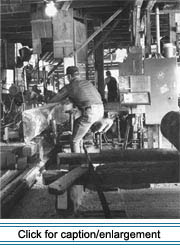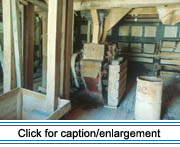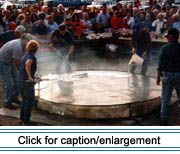|
Milling of lumber and flour has been a vital local occupation in the Valley
since the turn of the 19th century. Soon after his arrival in 1817, Nathan
Baker was operating a water-powered sawmill on what came to be known as
Baker Brook, and the business of milling lumber has been important in
the Valley since that time. Deane and Kavanagh reported in 1831 that there
were at least four operating lumber mills on the south shore. Industrial
mills were established in Fort Kent, Madawaska, Edmundston, Keegan, and
elsewhere during the 19th century. The railroad was extended at the turn
of the 20th century to serve the St. Francis mill.
 The
impact of the demise of the large lumber mill in Keegan, Van Buren, is
apparent today in abandoned properties and churches in communities where
large numbers of millworkers once lived, namely Lille, Grand Isle, Keegan,
and Van Buren. Small, individually owned and operated sawmills continue
to support local families. The Tardiff mill in Fort Kent Mills, for example,
produces custom sawn and rough-cut lumber from logs brought in by farmers
and woodlot owners. The smaller mills provide some local employment and
encourage farmers and independent contractors to embark upon projects
that would otherwise be too costly. Three lumber mills operated in Eagle
Lake until recently. The
impact of the demise of the large lumber mill in Keegan, Van Buren, is
apparent today in abandoned properties and churches in communities where
large numbers of millworkers once lived, namely Lille, Grand Isle, Keegan,
and Van Buren. Small, individually owned and operated sawmills continue
to support local families. The Tardiff mill in Fort Kent Mills, for example,
produces custom sawn and rough-cut lumber from logs brought in by farmers
and woodlot owners. The smaller mills provide some local employment and
encourage farmers and independent contractors to embark upon projects
that would otherwise be too costly. Three lumber mills operated in Eagle
Lake until recently.
The largest single employer in the Valley today is Fraser Paper Ltd.,
located both in Madawaska, Maine, and across the river in Edmundston, New Brunswick. It
employs approximately 1,800 workers. Fraser Ltd. has exercised a great
influence on the local economy since it purchased the James Murchie &
Sons mill in 1916 and opened business the next year (Lang 1987: 11). The
Murchie mill, which began operations in 1888, was one of the large sawmills
operating on the Upper St. John River during the 19th century industrialization
of the area.
Madawaska, Maine, and across the river in Edmundston, New Brunswick. It
employs approximately 1,800 workers. Fraser Ltd. has exercised a great
influence on the local economy since it purchased the James Murchie &
Sons mill in 1916 and opened business the next year (Lang 1987: 11). The
Murchie mill, which began operations in 1888, was one of the large sawmills
operating on the Upper St. John River during the 19th century industrialization
of the area.
|
 |
 |
Lumber mills are not the only mills that have been part of life in the
St. John Valley. There were gristmills, too, mentioned as early as 1790
(Craig pers. comm. 1993). Deane and Kavanagh (1831) reported five operating
gristmills. One early nineteenth-century mill (1807) remained in operation
in Frenchville until 1966. The present owner, Gédéon Corriveau, believes that he is the fifth owner of the mill complex
(Anwati and Roy 1981) which was equipped to perform three distinct operations.
In addition to the buckwheat mill, it included a lumber mill and a wool
carding machine. The Museum of American Textile History dates the carding
mill to 1801-1811 (David Raymond pers. comm. 1994) and it has been in
the Upper St. John Valley since the mid-nineteenth century. During the
20th century the mill complex was operated by steam, gasoline engine,
and finally electric motor. Aerial photographs reveal the mill's location
near a brook and a holding pond which could have provided hydraulic head
for the operation of a water wheel. The early equipment at this privately
owned site is in excellent condition, though the structure is deteriorating.
Gédéon Corriveau, believes that he is the fifth owner of the mill complex
(Anwati and Roy 1981) which was equipped to perform three distinct operations.
In addition to the buckwheat mill, it included a lumber mill and a wool
carding machine. The Museum of American Textile History dates the carding
mill to 1801-1811 (David Raymond pers. comm. 1994) and it has been in
the Upper St. John Valley since the mid-nineteenth century. During the
20th century the mill complex was operated by steam, gasoline engine,
and finally electric motor. Aerial photographs reveal the mill's location
near a brook and a holding pond which could have provided hydraulic head
for the operation of a water wheel. The early equipment at this privately
owned site is in excellent condition, though the structure is deteriorating.
The milling of buckwheat has considerable importance with regard to Acadian
cultural identity. Locally grown and milled buckwheat is the main ingredient
in ployes, a variety of thin pancake or crépe which is a local
food specialty. They can be ordered for lunch at area restaurants. Bouchard's Acadian Ploye Mix, manufactured by Alban
and Rita Bouchard of Fort Kent, is being marketed throughout the Valley,
all over Maine, and beyond. And, as the popularity of buckwheat flour
increases, so does the need for buckwheat mills. Buckwheat flour is presently
ground at small mills in New Brunswick. The Bouchard family and others
look forward to the day when buckwheat milling facilities are again available
in Maine.
area restaurants. Bouchard's Acadian Ploye Mix, manufactured by Alban
and Rita Bouchard of Fort Kent, is being marketed throughout the Valley,
all over Maine, and beyond. And, as the popularity of buckwheat flour
increases, so does the need for buckwheat mills. Buckwheat flour is presently
ground at small mills in New Brunswick. The Bouchard family and others
look forward to the day when buckwheat milling facilities are again available
in Maine.
|
|

